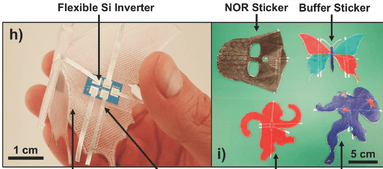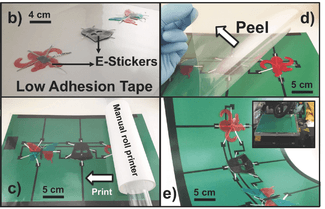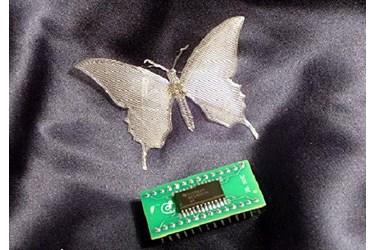KAUST Research Team 3D Prints Small Silicon-Based Computers to Use as Non-Invasive Health Monitor E-Stickers
 I have been lucky enough, so far in my life, as to not end up in a hospital bed multiple times (knock on wood!). I’m thankful for this, because I know that in a place where you’re supposed to be healing, it can be hard to get any rest because you’re usually hooked up to at least an IV pole, if not other health monitors, and that nurses and doctors have to come in and check your vitals at all hours of the day and night. So wouldn’t it be great if those same health monitors were small enough that they could be embedded inside our bodies, and track everything that goes on in there, so the 3 AM blood pressure checks could become a thing of the past? We’ve seen a 3D printed diagnostic device called MouthLab that brings to mind a Star Trek tricorder, but that still requires some level of active participation from the patient. But now, a new development from a team of researchers at King Abdullah University of Science and Technology (KAUST) in Saudi Arabia is bringing us one step closer. Their process prints high-performance, silicon-based computers on to soft, sticker-like surfaces that can be attached pretty much anywhere on your body.
I have been lucky enough, so far in my life, as to not end up in a hospital bed multiple times (knock on wood!). I’m thankful for this, because I know that in a place where you’re supposed to be healing, it can be hard to get any rest because you’re usually hooked up to at least an IV pole, if not other health monitors, and that nurses and doctors have to come in and check your vitals at all hours of the day and night. So wouldn’t it be great if those same health monitors were small enough that they could be embedded inside our bodies, and track everything that goes on in there, so the 3 AM blood pressure checks could become a thing of the past? We’ve seen a 3D printed diagnostic device called MouthLab that brings to mind a Star Trek tricorder, but that still requires some level of active participation from the patient. But now, a new development from a team of researchers at King Abdullah University of Science and Technology (KAUST) in Saudi Arabia is bringing us one step closer. Their process prints high-performance, silicon-based computers on to soft, sticker-like surfaces that can be attached pretty much anywhere on your body.

h) Digital photographs of packaged ZnO based inverter in 600 μm 3D printed polymer. i) Different packaged electronic components including NOR decals, NOT decals, NAND decals, and buffer decals.
These pressure-sensitive “e-stickers” are just as functional as regular silicon circuits, but now, they can be fabricated into fun, flexible shapes, such as butterflies or monkeys. The research team from the KAUST Computer, Electrical, and Mathematical Science and Engineering Division, led by scientist Muhammad Hussain, just published their study in the Advanced Material Technologies journal.
In order to handle monitoring applications, like digitizing analog signals, the flexible printed circuits need regular silicon components. The goal of this project is to create a non-invasive health monitor, but the researchers explained that rigid modules, like the silicon components, can increase the device weight and create hot spots on your body, defeating the purpose.
Hussain explained, “We are trying to integrate all device components-sensors, data management electronics, battery, antenna-into a completely compliant system. However, packaging these discrete modules on to soft substrates is difficult.”

Digital photographs of process followed to fabricate flexible RO packaged by 3D printing, inkjet printing for contact formation, and digital printing quality glossy paper as substrate.
Looking for a way to achieve their goal and find potential electronic skin applications, the team created a sensor, with narrow strips of aluminum foil inside, that will change electrical conductivity depending on how it is bent. Their technique, which involves printing conductive ink onto polymer and cellulose materials, allows for the devices to be produced with high speed and at low cost.
The team 3D printed the decal electronics using techniques that encased both the foil and silicon chips into a polymer film, backed by a layer of adhesive. High-mobility zinc oxide nanotransistors on silicon wafers enable maximum flexibility.
Doctors could use this device to monitor a patient’s activity levels or breathing patterns without having to attach a bulky, invasive object to the skin. But the team wanted to investigate if there was a way to make the e-sticker sensors work in other applications as well, so they used inkjet printing to write conductive wiring patterns onto a variety of surfaces, like clothing or paper, and the decals were then attached to different locations.
Galo Torres Sevilla, a KAUST Ph.D. graduate and the first author on the study, said, “You can place a pressure-sensing decal on a tire to monitor it while driving and then peel it off and place it on your mattress to learn your sleeping patterns.”
 It’s an appealing thought that instead of having to remove the tire cap and fit my tire pressure gauge tightly over the hole to see what my pressure is, I could instead put a sticker on the tire, and later use that same sticker to monitor my sleep. The team claims that the manufacturing potential for such high-performing decal electronics could potentially launch multiple innovative sensor deployments.
It’s an appealing thought that instead of having to remove the tire cap and fit my tire pressure gauge tightly over the hole to see what my pressure is, I could instead put a sticker on the tire, and later use that same sticker to monitor my sleep. The team claims that the manufacturing potential for such high-performing decal electronics could potentially launch multiple innovative sensor deployments.
Hussain said, “I believe that electronics have to be democratized – simple to learn and easy to implement. Electronic decals are a right step in that direction.”
Discuss in the 3D Printed Health Monitor forum at 3DPB.com.
[Sources: Futurism / newelectronics]
Subscribe to Our Email Newsletter
Stay up-to-date on all the latest news from the 3D printing industry and receive information and offers from third party vendors.
You May Also Like
Precision at the Microscale: UK Researchers Advance Medical Devices with BMF’s 3D Printing Tech
University of Nottingham researchers are using Boston Micro Fabrication‘s (BMF) 3D printing technology to develop medical devices that improve compatibility with human tissue. Funded by a UK grant, this project...
3D Printing Webinar and Event Roundup: April 21, 2024
It’s another busy week of webinars and events, starting with Hannover Messe in Germany and continuing with Metalcasting Congress, Chinaplas, TechBlick’s Innovation Festival, and more. Stratasys continues its advanced training...
3D Printing Webinar and Event Roundup: March 17, 2024
It’s another busy week of webinars and events, including SALMED 2024 and AM Forum in Berlin. Stratasys continues its in-person training and is offering two webinars, ASTM is holding a...
3D Printed Micro Antenna is 15% Smaller and 6X Lighter
Horizon Microtechnologies has achieved success in creating a high-frequency D-Band horn antenna through micro 3D printing. However, this achievement did not rely solely on 3D printing; it involved a combination...





























